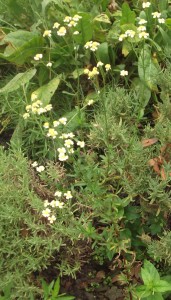 It’s a bit ragged now, and has had an attack of mildew which doesn’t add to its battered charms, but this is my row of alecost. This herb has a lot of other names some of which might be more familiar – costmary, sage o’bedlam, our lady’s mint, goosetongue, and one which comes from America – bibleleaf, because it was placed between the pages of your bible so that its scent would be refreshing and stimulating if you got sleepy during the sermon.
It’s a bit ragged now, and has had an attack of mildew which doesn’t add to its battered charms, but this is my row of alecost. This herb has a lot of other names some of which might be more familiar – costmary, sage o’bedlam, our lady’s mint, goosetongue, and one which comes from America – bibleleaf, because it was placed between the pages of your bible so that its scent would be refreshing and stimulating if you got sleepy during the sermon.
At other times it was also known as mace or allspice, because of the tangy spicy edge to its taste. This confused me a little at first, as there is also
 (the small white flowers among the lavender). Jekka Mcvicar calls this English mace. It’s Latin name is achillea ageratum, which makes it a relative of yarrow, whereas alecost is tanacetum balsamita – so related to tansy.
(the small white flowers among the lavender). Jekka Mcvicar calls this English mace. It’s Latin name is achillea ageratum, which makes it a relative of yarrow, whereas alecost is tanacetum balsamita – so related to tansy.
It was traditionally used to ease the pain of childbirth, and also for headaches, catarrh and stomach upsets, but its best use is for pot pourri. As well as having a really good scent in itself, it contains coumarin, which helps to intensify and preserve the scents of other leaves and flowers.
 As I’m about to make my potpourri this week, this herb is just what I need.
As I’m about to make my potpourri this week, this herb is just what I need.
Leave a Reply